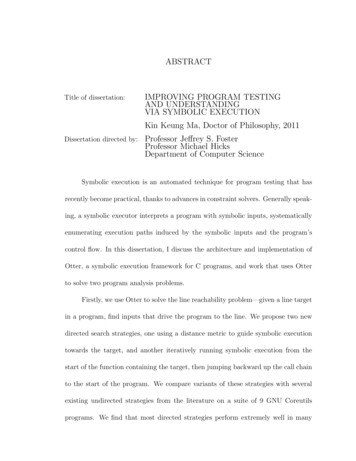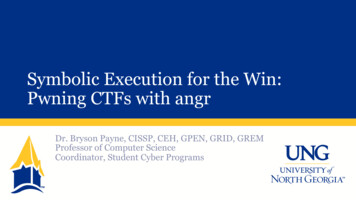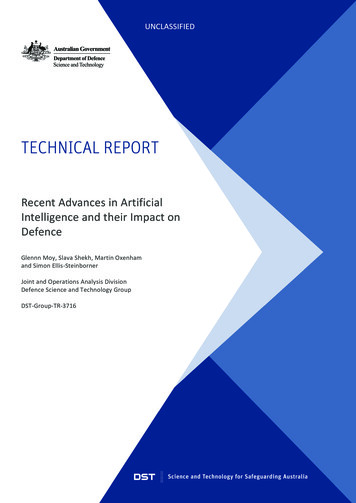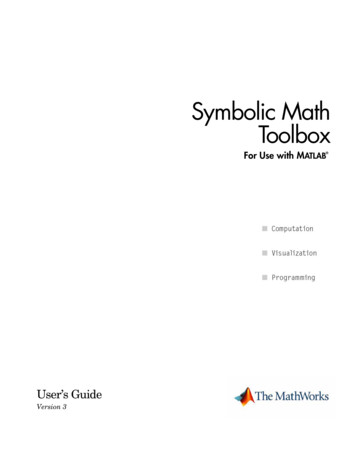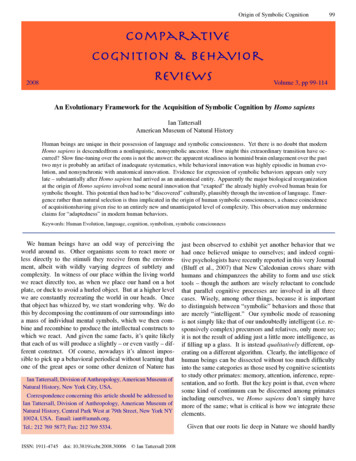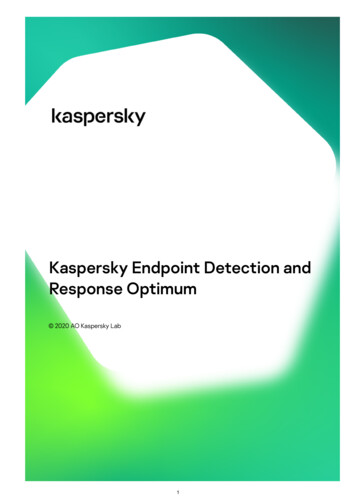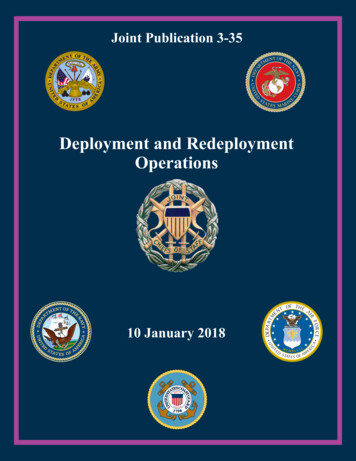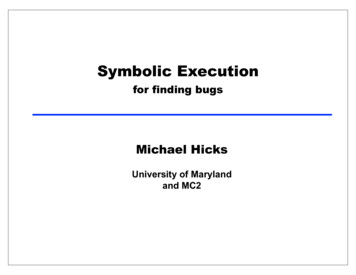
Transcription
Symbolic Executionfor finding bugsMichael HicksUniversity of Marylandand MC2
Software has bugs To find them, we use testing and code reviews But some bugs are still missed Rare features Rare circumstances Nondeterminism2
Static analysis Can analyze all possible runs of a program Lots of interesting ideas and tools Commercial companies sell, use static analysis It all looks good on paper, and in papers#!@? But can developers use it? Our experience: Not easily Results in papers describe use by static analysis experts Commercial viability implies you must deal withdeveloper confusion, false positives, error management,.3
One Issue: Abstraction Abstraction lets us scale and model all possible runs But it also introduces conservatism *-sensitivities attempt to deal with this- * flow-, context-, path-, field-, etc But they are never enough Static analysis abstraction developer abstraction Because the developer didn’t have them in mind4
Symbolic execution: a middle ground Testing works But, each test only explores one possible execution- assert(f(3) 5) We hope test cases generalize, but no guarantees Symbolic execution generalizes testing Allows unknown symbolic variables in evaluation- y α; assert(f(y) 2*y-1); If execution path depends on unknown, conceptuallyfork symbolic executor- int f(int x) { if (x 0) then return 2*x - 1; else return 10; }5
Symbolic Execution Exampleint a α, b β, c γ;2.// symbolic3. int x 0, y 0, z 0;4. if (a) {5. x -2;6. }7. if (b 5) {8. if (!a && c) { y 1; }9. z 2;10.}11.assert(x y z! 3)x 0, y 0, z 01.tαfx -2tβ 5z 2 α (β 5)tfβ 5 α γt y 1α (β 5)z 2f α (β 5)fz 2 α (β 5) γ α (β 5) γpath condition6
Insight Each symbolic execution path stands for manyactually program runs In fact, exactly the set of runs whose concrete valuessatisfy the path condition Thus, we can cover a lot more of the program’sexecution space than testing7
Early work on symbolic execution Robert S. Boyer, Bernard Elspas, and Karl N. Levitt.SELECT–a formal system for testing and debuggingprograms by symbolic execution. In ICRS, pages 234–245, 1975. James C. King. Symbolic execution and program testing.CACM, 19(7):385–394, 1976. (most cited) Leon J. Osterweil and Lloyd D. Fosdick. Program testingtechniques using simulated execution. In ANSS, pages171–177, 1976. William E. Howden. Symbolic testing and the DISSECTsymbolic evaluation system. IEEE Transactions onSoftware Engineering, 3(4):266–278, 1977.8
The problem Computers were small (not much memory) andslow (not much processing power) Apple’s iPad 2 is as fast as a Cray-2 from the 1980’s Symbolic execution can be extremely expensive Lots of possible program paths Need to query solver a lot to decide which paths arefeasible, which assertions could be false Program state has many bits9
Today Computers are much faster, memory is cheap There are very powerful SMT/SAT solvers today SMT Satisfiability Modulo Theories SAT Can solve very large instances, very quickly- Lets us check assertions, prune infeasible paths We’ve used Z3, STP, and Yices Recent success: bug finding Heuristic search through space of possible executions Find really interesting bugs10
1E 181E 16Dongarra and Luszczek, Anatomy of a Globally RecursiveEmbedded LINPACK Benchmark, HPEC 2012.http://web.eecs.utk.edu/ luszczek/pubs/hpec2012 elb.pdf1E 141E 121E 101E 81E 61E 41E 21E 019501960HPEC 2012Waltham, MASeptember 10-12, 2012197019801990200020102020
Remainder of the tutorial The basics, in code Scaling up The search space Hard-to-handle features Existing tools KLEE: one industrial grade tool KLEE lab: using KLEE to find bugs Including vulnerabilities12
Symbolic Execution for IMPa :: n X a0 a1 a0-a1 a0 a1b :: bv a0 a1 a0 a1 b b0 b1 b0 b1c :: skip X: a goto pc if b then pc assert bp :: c; .; c n N integers, X Var variables, bv Bool {true, false} This is a typical way of presenting a language Notice grammar is for ASTs- Not concerned about issues like ambiguity, associativity, precedence Syntax stratified into commands (c) and expressions (a,b) Expressions have no side effects No function calls (and no higher order functions)13
Interpretation for IMP See main.ml How to extend this to be a symbolic executor?14
Symbolic Variables Add a new kind of expressiontype aexpr . ASym of stringtype bexpr . BSym of string The string is the variable name Naming variables is useful for understanding the output ofthe symbolic executor15
Symbolic Expressions Now change aeval and beval to work with symbolicexpressionslet rec aeval sigma function ASym s - new symbolic variable 32 s (* 32-bit *) APlus (a1, a2) - symbolic plus (aeval sigma a1) (aeval sigma a2) .let rec beval sigma function BSym s - new symbolic variable 1 s (* 1 bit *) BLeq (a1, a2) - symbolic leq (aeval sigma a1) (aeval sigma a2) .16
Symbolic State Previous step function, roughly speakingcstep : sigma - pc - (sigma’, pc’) Now we have a couple of issues: We need to keep track of the path condition There may be more than one pc if we fork execution Convenient to package all this up in a record, andchange cstep appropriatelytype state {sigma : (string * symbolic expr) list;pc : int;path : symbolic expr;}cstep : state - state * (state option)17
Forking Execution How to decide which branches are feasible? Combine path condition with branch cond and ask solver!let cstep st function CIf (b, pc’) - let b’ beval st.sigma b inlet t path cond symbolic and st.path b’ inlet f path cond symbolic and st.path (symbolic not b’) inlet maybe t satisfiable t path cond inlet maybe f satisfiable f path cond inmatch maybe t, maybe f with true, true - (* true path *), Some (* false path *) true, false - (* true path *), None false, true - (* false path *), None false, false - (* impossible *)18
Top-level Driver1. create initial state- pc 0, path cond true, state empty2. push state onto worklist3. while (worklist is not empty)3a. st pull some state from worklist3b. st’, st’’ cstep st3c. add st’ to worklist3d. add st’’’ to worklist if st’’ Some st’’’19
Path explosion Usually can’t run symbolic execution to exhaustion Exponential in branching structure1.2.3.4.int a α, b β, c γ;if (a) . else .;if (b) . else .;if (c) . else .;// symbolic- Ex: 3 variables, 8 program paths Loops on symbolic variables even worse1.2.int a α; // symbolicwhile (a) do .;3.- Potentially 2 31 paths through loop!20
Basic search Simplest ideas: algorithms 101 Depth-first search (DFS) Breadth-first search (BFS) Potential drawbacks Neither is guided by any higher-level knowledge- Probably a bad signDFS could easily get stuck in one part of the program- E.g., it could keep going around a loop over and over againOf these two, BFS is a better choice21
Search strategies Need to prioritize search Try to steer search towards paths more likely to containassertion failures Only run for a certain length of time- So if we don’t find a bug/vulnerability within time budget, too bad Think of program execution as a DAG Nodes program states Edge(n1,n2) can transition from state n1 to state n2 Then we need some kind of graph explorationstrategy At each step, pick among all possible paths22
Randomness We don’t know a priori which paths to take, soadding some randomness seems like a good idea Idea 1: pick next path to explore uniformly at random(Random Path, RP) Idea 2: randomly restart search if haven’t hit anythinginteresting in a while Idea 3: when have equal priority paths to explore, choosenext one at random- All of these are good ideas, and randomness is very effective One drawback: reproducibility Probably good to use psuedo-randomness based on seed,and then record which seed is picked (More important for symbolic execution implementers thanusers)23
Coverage-guided heuristics Idea: Try to visit statements we haven’t seen before Approach Score of statement # times it’s been seen and how often Pick next statement to explore that has lowest score Why might this work? Errors are often in hard-to-reach parts of the program This strategy tries to reach everywhere. Why might this not work? Maybe never be able to get to a statement if properprecondition not set up KLEE RP coverage-guided24
Generational search Hybrid of BFS and coverage-guided Generation 0: pick one program at random, run tocompletion Generation 1: take paths from gen 0, negate onebranch condition on a path to yield a new pathprefix, find a solution for that path prefix, and thentake the resulting path Note will semi-randomly assign to any variables notconstrained by the path prefix Generation n: similar, but branching off gen n-1 Also uses a coverage heuristic to pick priority25
Combined search Run multiple searches at the same time Alternate between them E.g., Fitnext Idea: no one-size-fits-all solution Depends on conditions needed to exhibit bug So will be as good as “best” solution, which a constantfactor for wasting time with other algorithms Could potentially use different algorithms to reach differentparts of the program26
SMT solver performance SAT solvers are at core of SMT solvers In theory, could reduce all SMT queries to SAT queries In practice, SMT and higher-level optimizations are critical Some examples Simple identities (x 0 x, x * 0 0) Theory of arrays (read(42, write(42, x, A)) x)- 42 array index, A array, x elementCaching (memoize solver queries) Remove useless variables- E.g., if trying to show path feasible, only the part of the path conditionrelated to variables in guard are important27
Libraries and native code At some point, symbolic execution will reach the“edges” of the application Library, system, or assembly code calls In some cases, could pull in that code also E.g., pull in libc and symbolically execute it But glibc is insanely complicated- Symbolic execution can easily get stuck in itpull in a simpler version of libc, e.g., newlib - libc versions for embedded systems tend to be simpler In other cases, need to make models of code E.g., implement ramdisk to model kernel fs code This is a lot of work!28
Concolic execution Also called dynamic symbolic execution Instrument the program to do symbolicexecution as the program runs I.e., shadow concrete program state with symbolicvariables Explore one path at a time, start to finish Always have a concrete underlying value to rely on29
Concretization Concolic execution makes it really easy toconcretize Replace symbolic variables with concrete values thatsatisfy the path condition- Always have these around in concolic execution So, could actually do system calls But we lose symbolic-ness at such calls And can handle cases when conditions toocomplex for SMT solver But can do the same in pure symbolic system30
Resurgence of symbolic exection Two key systems that triggered revival of this topic: DART — Godefroid and Sen, PLDI 2005- Godefroid model checking, formal systems background EXE — Cadar, Ganesh, Pawlowski, Dill, and Engler, CCS2006- Ganesh and Dill SMT solver called “STP” (used inimplementation)- Theory of arrays- Cadar and Engler systems31
Recent successes, run on binaries SAGE Microsoft (Godefroid) concolic executor Symbolic execution to find bugs in file parsers- E.g., JPEG, DOCX, PPT, etc Cluster of n machines continually running SAGE Mayhem Developed at CMU (Brumley et al), runs on binaries Uses BFS-style search and native execution Automatically generates exploits when bugs found32
KLEE Symbolically executes LLVM bitcode LLVM compiles source file to .bc file KLEE runs the .bc file Works in the style of our example interpreter Uses fork() to manage multiple states Employs a variety of search strategies Mocks up the environment to deal with system calls,file accesses, etc.33
KLEE: Coverage for Coreutilsklee vs. Manual (ELOC %)100%paste -d\\ apr -e t2.txttac -r t3.txmkdir -Z a bmkfifo -Z amknod -Z a bmd5sum -c t1ptx -F\\ abcptx x t4.txtseq -f %0 150%0% 50% 100%110255075Figure 6: Relative coverage difference between KLEE andthe C OREUTILS manual test suite, computed by subtractingthe executable lines of code covered by manual tests (Lman )from KLEE tests (Lklee ) and dividing by the total possible:(Lklee Lman )/Ltotal . Higher bars are better for KLEE ,which beats manual testing on all but 9 applications, oftensignificantly.t1.txt:t2.txt:t3.txt:t4.txt:"\t \tMD"\b\b\b\"\n""a"Figure 7: KLEE -genefied for readability) thversion 6.10 when ruPentium machine.Cadar, Dunbar, and Engler. KLEE: Unassisted and Automatic Generation of High-Coverage Tests for34Complex Systems Programs, OSDI 2008KLEE achieves 76.95.2.2 Comparison against developer test suites
KLEE: Coreutils crashespaste -d\\ abcdefghijklmnopqrstuvwxyzpr -e t2.txttac -r t3.txt t3.txtmkdir -Z a bmkfifo -Z a bmknod -Z a b pmd5sum -c t1.txtptx -F\\ abcdefghijklmnopqrstuvwxyzptx x t4.txtseq -f %0 175een KLEE andby subtractingual tests (Lman )total possible:tter for KLEE ,cations, oftentest suitest1.txt:t2.txt:t3.txt:t4.txt:"\t \tMD5(""\b\b\b\b\b\b\b\t""\n""a"Figure 7: KLEE -generated command lines and inputs (modified for readability) that cause program crashes in C OREUTILSversion 6.10 when run on Fedora Core 7 with SELinux on aPentium machine.Cadar, Dunbar, and Engler. KLEE: Unassisted and Automatic Generation of High-Coverage Tests forComplex Systems Programs, OSDI 2008KLEE achieves 76.9% overall branch coverage, while the35
Other symbolic executors Cloud9 — parallel symbolic execution, alsosupports threads Pex — symbolic execution for .NET jCUTE — symbolic execution for Java Java PathFinder — a model checker that alsosupports symbolic execution36
Research tools at UMD Otter — symbolic executor for C Better library model than KLEE, support formultiprocess symbolic execution Supports directed symbolic execution: give the tool aline number, and it try to generate a test case to getthere RubyX — symbolic executor for Ruby SymDroid — symbolic executor for Dalvikbytecode37
Lab Now will try out KLEE To get started, go to http://www.cs.umd.edu/ mwh/se-tutorial/ We will get the basics working and then try toreproduce some of the coreutils bugs38
Today Computers are much faster, memory is cheap There are very powerful SMT/SAT solvers today SMT Satisfiability Modulo Theories SAT Can solve very large instances, very quickly-Lets us check assertions, prune infeasible paths We've used Z3, STP, and Yices Recent success: bug finding


